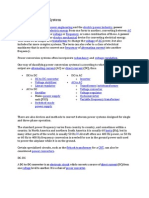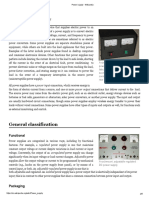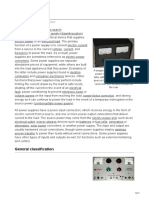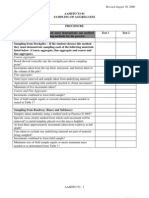SMPS
SMPS
Uploaded by
sahilfriendmailCopyright:
Available Formats
SMPS
SMPS
Uploaded by
sahilfriendmailOriginal Description:
Copyright
Available Formats
Share this document
Did you find this document useful?
Is this content inappropriate?
Copyright:
Available Formats
SMPS
SMPS
Uploaded by
sahilfriendmailCopyright:
Available Formats
Switched-mode power supply A switched-mode power supply (switching-mode power supply, SMPS, or switcher) is an electronic power supply that
incorporates a switching regulator to convert electrical power efficiently. Like other power supplies, an SMPS transfers power from a source, like mains power, to a load, such as a personal computer, while converting voltage and current characteristics. An SMPS is usually employed to efficiently provide a regulated output voltage, typically at a level different from the input voltage.
Unlike a linear power supply, the pass transistor of a switching-mode supply continually switches between low-dissipation, full-on and full-off states, and spends very little time in the high dissipation transitions (which minimizes wasted energy). Ideally, a switched-mode power supply dissipates no power. Voltage regulation is achieved by varying the ratio of on-to-off time. In contrast, a linear power supply regulates the output voltage by continually dissipating power in the pass transistor. This higher power conversion efficiency is an important advantage of a switched-mode power supply. Switched-mode power supplies may also be substantially smaller and lighter than a linear supply due to the smaller transformer size and weight.
Switching regulators are used as replacements for the linear regulators when higher efficiency, smaller size or lighter weight are required. They are, however, more complicated; their switching currents can cause electrical noise problems if not carefully suppressed, and simple designs may have a poor power factor.
Explanation
A linear regulator provides the desired output voltage by dissipating excess power in ohmic losses (e.g., in a resistor or in the collectoremitter region of a pass transistor in its active mode). A linear regulator regulates either output voltage or current by dissipating the excess electric power in the form of heat, and hence its maximum power efficiency is voltage-out/voltage-in since the volt difference is wasted. In contrast, a switched-mode power supply regulates either output voltage or current by switching ideal storage elements, like inductors and capacitors, into and out of different electrical configurations. Ideal switching elements (e.g., transistors operated outside of their active mode) have no resistance when "closed" and carry no current when "open", and so the converters can theoretically operate with 100% efficiency (i.e., all input power is delivered to the load; no power is wasted as dissipated heat). For example, if a DC source, an inductor, a switch, and the corresponding electrical ground are placed in series and the switch is driven by a square wave, the peak-to-peak voltage of the waveform measured across the switch can exceed the input voltage from the DC source. This is because the inductor responds to changes in current by inducing its own voltage to counter the change in current, and this voltage adds to the source voltage while the switch is open. If a diode-andcapacitor combination is placed in parallel to the switch, the peak voltage can be stored in the capacitor, and the capacitor can be used as a DC source with an output voltage greater than the DC voltage driving the circuit. This boost converter acts like a step-up transformer for DC signals. A buckboost converter works in a similar manner, but yields an output voltage which is opposite in polarity to the input voltage. Other buck circuits exist to boost the average output current with a reduction of voltage.
Block diagram of a mains operated AC/DC SMPS with output voltage regulation
Reference : http://en.wikipedia.org/wiki/Switched-mode_power_supply
You might also like
- SMPS PPT Summer Traning by VijayDocument60 pagesSMPS PPT Summer Traning by VijayVijay Kaplsya86% (7)
- SMPSDocument2 pagesSMPSsumit86No ratings yet
- SMPS TutorialDocument18 pagesSMPS TutorialUmasankar Peri100% (1)
- SMPS:-: Switched-Mode Power Supply (Switching-Mode Power Supply, SMPS, or Simplyswitcher) Is An ElectronicDocument4 pagesSMPS:-: Switched-Mode Power Supply (Switching-Mode Power Supply, SMPS, or Simplyswitcher) Is An ElectronicSumit SrivastavaNo ratings yet
- DC-DC ConverterDocument12 pagesDC-DC ConvertersabariNo ratings yet
- Power Supplies Module 03Document20 pagesPower Supplies Module 03LeonardoXanMNo ratings yet
- Sem ReportDocument38 pagesSem ReportSafalsha BabuNo ratings yet
- Power Supply FunctionDocument4 pagesPower Supply FunctiondunkinkunatNo ratings yet
- Power Supply - WikipediaDocument14 pagesPower Supply - WikipediaaronsanjayNo ratings yet
- Power Conversion SystemDocument6 pagesPower Conversion SystemDanica Nicole BuhatNo ratings yet
- Regulated DC Power SupplyDocument15 pagesRegulated DC Power SupplynalumilanimeNo ratings yet
- How An Smps Works: Rectifier StageDocument7 pagesHow An Smps Works: Rectifier StageImran AshrafNo ratings yet
- How An SMPS WorksDocument7 pagesHow An SMPS WorksĐorđe PopovićNo ratings yet
- Power SupplyDocument9 pagesPower SupplyMuhammed HuzaifaNo ratings yet
- SMPSDocument1 pageSMPSNiteshNo ratings yet
- Switch Mode Power Supply and Switching RegulatorsDocument13 pagesSwitch Mode Power Supply and Switching Regulatorsyuj oNo ratings yet
- Switch Mode Power Supply and Switching RegulatorsDocument10 pagesSwitch Mode Power Supply and Switching Regulatorsmarcoms75No ratings yet
- Has High Efficiency. Fault Current Is Limited by The Inductor Output Short Circuit Current Is Easy To ImplementDocument6 pagesHas High Efficiency. Fault Current Is Limited by The Inductor Output Short Circuit Current Is Easy To ImplementRajalakshmi ShivakumarNo ratings yet
- Power Supply - WikipediaDocument4 pagesPower Supply - Wikipediaaravind balaNo ratings yet
- KMT#4Document5 pagesKMT#4RomanHerreraNo ratings yet
- A Power Supply Is A Device That Supplies Electric Power To An Electrical LoadDocument14 pagesA Power Supply Is A Device That Supplies Electric Power To An Electrical LoadElizabeth HarrisNo ratings yet
- Swtched - Mode Power SupplyDocument13 pagesSwtched - Mode Power Supplynitinhanda100% (1)
- Switched Mode Power SupplyDocument10 pagesSwitched Mode Power SupplySukhminder WaliaNo ratings yet
- Power Supply: General ClassificationDocument11 pagesPower Supply: General ClassificationfabiobonadiaNo ratings yet
- What Is Power SupplyDocument11 pagesWhat Is Power SupplyVok Jia JunNo ratings yet
- DC DC ConvertorDocument6 pagesDC DC ConvertorFlorin CristiNo ratings yet
- Uday Edition 03Document12 pagesUday Edition 03Gulani Sai TejANo ratings yet
- Power SupplyDocument13 pagesPower SupplyDinesh MahajanNo ratings yet
- A Power Supply UnitDocument11 pagesA Power Supply UnitShin Jae JiNo ratings yet
- Power SupplyDocument3 pagesPower SupplyErole Technologies Pvt ltd Homemade EngineerNo ratings yet
- Supplies (SMPS) - The Various Types of Voltage Regulators, Used in Linear Power Supplies (LPS), Fall inDocument4 pagesSupplies (SMPS) - The Various Types of Voltage Regulators, Used in Linear Power Supplies (LPS), Fall inrakhikrishnarpillaiNo ratings yet
- Welcome To All The Teacher's Of: SmitDocument30 pagesWelcome To All The Teacher's Of: Smitsrvdhar100% (2)
- Term Paper On Construction of 12 Volts Power SupplyDocument15 pagesTerm Paper On Construction of 12 Volts Power SupplyVictor ImehNo ratings yet
- Transformer Type & TutorialDocument106 pagesTransformer Type & TutorialHasan Basyaria100% (1)
- Power Supply: Citations VerificationDocument30 pagesPower Supply: Citations VerificationIvy TomasNo ratings yet
- Current TransformerDocument8 pagesCurrent Transformernangedla praveenNo ratings yet
- (Edit) Power Supply TypesDocument8 pages(Edit) Power Supply Typeshazel violetNo ratings yet
- SMPSDocument5 pagesSMPSGunadevan ChandrasekaranNo ratings yet
- Introduction To Switched Mode Power Supplies.: Fig.3.0.1 Typical SMPS Block DiagramDocument17 pagesIntroduction To Switched Mode Power Supplies.: Fig.3.0.1 Typical SMPS Block DiagramPhenias ManyashaNo ratings yet
- BuckDocument2 pagesBuckJeyakumar VenugopalNo ratings yet
- Power System Analysis Lab Equipments: ObjectiveDocument12 pagesPower System Analysis Lab Equipments: Objectiveayesha amjadNo ratings yet
- Power Electronics NotesDocument2 pagesPower Electronics Notesprasad3570% (1)
- Switch Mode Power Supply Basics TutorialDocument16 pagesSwitch Mode Power Supply Basics TutorialDavidNo ratings yet
- 10SMPSDocument25 pages10SMPSangayarkanni.sundaraNo ratings yet
- Classification of Power Supply and Its Different TypesDocument27 pagesClassification of Power Supply and Its Different TypesAizel Jacob RoncejeroNo ratings yet
- Final ReviewDocument19 pagesFinal ReviewSanyam JainNo ratings yet
- Switched Mode Power SupplyDocument153 pagesSwitched Mode Power SupplyIvan222244No ratings yet
- 1000w Inverter PURE SINE WAVE Schematic DiagramDocument153 pages1000w Inverter PURE SINE WAVE Schematic Diagramjeevapillay100% (4)
- Chapter - I 1.1 GeneralDocument67 pagesChapter - I 1.1 GeneralJilly ArasuNo ratings yet
- Power FactorDocument9 pagesPower Factorlucian1961No ratings yet
- A Technical Guide To Smps AdaptersDocument28 pagesA Technical Guide To Smps AdaptersHitesh MehtaNo ratings yet
- Reference Guide To Useful Electronic Circuits And Circuit Design Techniques - Part 1From EverandReference Guide To Useful Electronic Circuits And Circuit Design Techniques - Part 1Rating: 2.5 out of 5 stars2.5/5 (3)
- STEM: Science, Technology, Engineering and Maths Principles Teachers Pack V10From EverandSTEM: Science, Technology, Engineering and Maths Principles Teachers Pack V10No ratings yet
- Git MCQ Valume CDocument34 pagesGit MCQ Valume CAhmed ElwassiefNo ratings yet
- Work, Power and-WPS OfficeDocument14 pagesWork, Power and-WPS Officearyanbhai.fkNo ratings yet
- International Journal of Technical Innovation in Modern Engineering & Science (IJTIMES)Document7 pagesInternational Journal of Technical Innovation in Modern Engineering & Science (IJTIMES)Rohit AmareshNo ratings yet
- Hortatory ExpositionDocument3 pagesHortatory ExpositionRahardian OkaNo ratings yet
- CNC Program SheetDocument10 pagesCNC Program SheetNemikumar Gandhi100% (1)
- Ridgid Precision Flaring Tools ManualDocument1 pageRidgid Precision Flaring Tools ManualmaftmutoNo ratings yet
- FELIX2Document2 pagesFELIX2echo alisboNo ratings yet
- Mathematics-Form 3-Chapter 1 Lines and Angle II by KelvinDocument6 pagesMathematics-Form 3-Chapter 1 Lines and Angle II by KelvinKelvinNo ratings yet
- M.E (CS) EceDocument38 pagesM.E (CS) EceGopikrishnan RadhakrishnanNo ratings yet
- What Is TourismDocument12 pagesWhat Is Tourismtanvi2009No ratings yet
- Chapter 02Document28 pagesChapter 02society RejectedNo ratings yet
- 2020 Mango Integrated Pest ManagementDocument19 pages2020 Mango Integrated Pest ManagementAgot RosarioNo ratings yet
- 4KHỐI 10 - UNIT 4-NGUYỄN THỊ LÂM-THPT NGUYỄN DUDocument8 pages4KHỐI 10 - UNIT 4-NGUYỄN THỊ LÂM-THPT NGUYỄN DUPhương Trinh Trần NguyễnNo ratings yet
- AASHTO-T2 Sampling AggregatesDocument3 pagesAASHTO-T2 Sampling AggregatesJeselen Arias100% (1)
- 02 Transmission Media PROFIBUSDocument22 pages02 Transmission Media PROFIBUSIsai AnguianoNo ratings yet
- Dynomite Dynamometer Accessories CatalogDocument52 pagesDynomite Dynamometer Accessories Catalogعبدالله عمرNo ratings yet
- Machine Design IDocument2 pagesMachine Design IBhavesh PipaliyaNo ratings yet
- Sustainable Development Project X-B Meghabarna PatraDocument11 pagesSustainable Development Project X-B Meghabarna Patranamitaankit90No ratings yet
- What Women Want - What Men WantDocument300 pagesWhat Women Want - What Men Wanta1954908100% (14)
- Plan, Prepare and Display A Buffet Service: D1.HCC - CL2.07 Trainee ManualDocument76 pagesPlan, Prepare and Display A Buffet Service: D1.HCC - CL2.07 Trainee Manualوالو وخلاصNo ratings yet
- AP Chemistry Unit 7 General Equilibrium Free Response Practice OldDocument2 pagesAP Chemistry Unit 7 General Equilibrium Free Response Practice Oldfrenchbunny0709No ratings yet
- Development of Large-Strain Macrobend Optical-Fiber Sensor With Helical-Bending Structure For Pavement Monitoring ApplicationDocument10 pagesDevelopment of Large-Strain Macrobend Optical-Fiber Sensor With Helical-Bending Structure For Pavement Monitoring ApplicationGaurav KumarNo ratings yet
- Flexible 3GPP MIMO Channel Modeling and Calibration With Spatial ConsistencyDocument18 pagesFlexible 3GPP MIMO Channel Modeling and Calibration With Spatial ConsistencySambasivaNo ratings yet
- English Terms For CR 1-1-4Document23 pagesEnglish Terms For CR 1-1-4mario_gNo ratings yet
- DrugsDocument2 pagesDrugsKrestine MolleNo ratings yet
- Weather Monitoring System For Solar & Wind ProjectsDocument24 pagesWeather Monitoring System For Solar & Wind ProjectsNarasimha DvlNo ratings yet
- English Language Year 2 Paper 013 (Pemahaman) 2016Document10 pagesEnglish Language Year 2 Paper 013 (Pemahaman) 2016Patrick TawieNo ratings yet
- Water Policies in Mena Countries: Slim Zekri EditorDocument208 pagesWater Policies in Mena Countries: Slim Zekri EditorvfvNo ratings yet
- 16 - English - Semi Prelim Ii - Paper - Iv (First Language) (E)Document9 pages16 - English - Semi Prelim Ii - Paper - Iv (First Language) (E)Amjad KhanNo ratings yet
- Human Evolution CL 2019Document56 pagesHuman Evolution CL 2019Masentle MonicaNo ratings yet

























































































